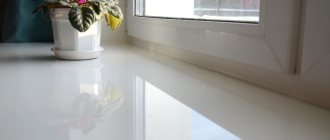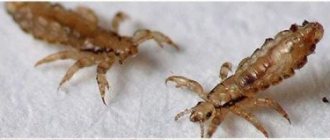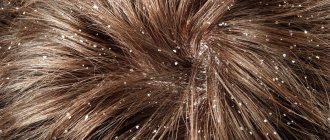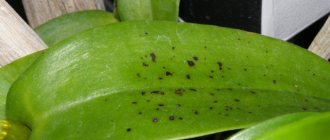External manifestations
When a novice or not very experienced gardener discovers a deviation in flowers (for example, the same stickiness), he immediately begins to panic. But panic needs to be put aside and a thorough examination must be carried out.
Analyze what stickiness looks like and in what form it appears. After all, this symptom can manifest itself in different ways:
- sticky droplets of some liquid hang on the leaves;
- stickiness is located along the entire length of the sheet in the form of spots;
- present on leaf blades in the form of a white coating.
Each of the listed symptoms is characteristic of a specific disease (or pest), so do not neglect to examine the phalaenopsis before treatment.
Drops and spots that look like liquid resin
Such spots can spread over the entire length of the phalaenopsis leaf blade. Usually such defects have a clearly defined border, so that the leaves appear to be covered with dew. Such drops rarely merge into a single mass and remain as separate transparent fragments on the body of the leaf.
White coating
The white sticky coating on the leaf blades of orchids looks as if the leaves have suddenly changed color. A whitish tint seems to appear from inside the body of the leaf, completely changing its shade.
When is stickiness a natural process?
The natural stickiness of leaves in orchids is called transpiration . During this process, moisture begins to evaporate from the plant’s cellular system and then settle on the leaf plates.
Sometimes sticky nectar, which is formed from phalaenopsis sugars, may also appear on the leaves. It is this that attracts insects that pollinate flowers.
Harmful insects are not too fond of orchids in their natural habitat (in the tropics), since for them the smell of the nectar formed on the leaves is unbearable. It repels pests and protects the plant from their encroachment.
Nectar usually appears only on the upper part of the leaf . So if you notice that stickiness has appeared on the lower half of the plate, then this is a reason to sound the alarm.
Despite the fact that the formation of nectar is a normal process in orchids, it is still worth carefully removing it from home flowers. This will help protect them from pathogens of various diseases that love the nutrient medium.
What to do first?
When a white coating appears on an orchid, it is necessary to initially examine not only the diseased plant, but also those adjacent to it. All flowers on which suspicious signs were found must be quarantined and moved to a secluded place.
If powdery mildew develops, it is necessary to initially limit watering, allow the substrate to dry out, and also adjust the temperature.
Causes
The reasons for the appearance of a sticky coating on orchid leaves can be different . It can appear as a result of the natural process of nectar synthesis, or it can signal improper care, illness or the presence of pests in phalaenopsis.
So a preliminary thorough inspection is a prerequisite for further action.
Next, we suggest watching a video about the reasons for the appearance of sticky drops on an orchid:
Pests and diseases
The appearance of a sticky coating on the leaves of a plant may be caused by the activity of harmful insects.
Mealybug (powdery mildew)
Sometimes this pest can be confused with another one - scale insects. It can settle not only directly on the plant, but also next to it, for example, in the soil. The larvae of the pest and its adults gnaw channels in the leaves and stems and suck out the life-giving juice of the plant through them. Sticky plaque is secretory fluids left behind by parasites .
Toxic compounds synthesized by pests enter the orchid's vascular system, so that the channels become clogged, weaken, and the plant gradually dies.
Attention! Traces of the presence of mealybugs can appear not only on the upper part of the leaf blades, but also on the lower half and even on the stems of the plant.
Shchitovka
One of the fastest growing pests of orchids . Female scale insects store eggs under their shell, so that at any time they can lay eggs, from which larvae will hatch, capable of moving independently from the first days of life.
The pest larvae crawl along leaf plates, shoots, and stems, looking for a place where they could gain a foothold with the help of their proboscis and wait for them to mature and lay new eggs. So the sticky marks on the leaves are the result of the life activity of this pest.
Scale insects feed on sweetish juice contained in the tissues of phalaenopsis. That is why enteric-contact types of insecticides are used to control parasites.
They water the soil in the planting container, so that when the scale insect again decides to drink the sweet juice from the orchid, it will be poisoned and die.
Aphid
Aphids can be distinguished by the curled sticky leaves and wilted inflorescences remaining from their activity. Aphids also feed on the sweet juice of the orchid , gradually sucking literally all the life out of it. Due to lack of nutrition, phalaenopsis dies.
It is necessary to take action as early as possible, since delay can lead to secondary infection with sooty fungus.
Pest control is usually carried out using insecticides, but before using them, treat the shoots with a soap solution containing tobacco.
Whitefly
Miniature white butterflies, called whiteflies, are able to gnaw through the top layer of plant tissue and suck out the sweetish juice. and yellowish stains remain on the leaves and stems of phalaenopsis
Many gardeners try to deal with the butterfly using sticky fly traps, but most often they simply do not have time to notice the presence of the pest in time, so that it already manages to settle on the plant and lay eggs. In such a fight, it is better to give preference to high-quality insecticides.
Important! After treating the orchid with the drug, cover it with film to destroy not only the adults, but also the larvae.
Overfeeding the plant
Excess feeding can also negatively affect the health of the orchid . Sticky droplets will appear on the plant over time. It will be difficult to determine by eye whether a large amount of fertilizer, improper watering or pest activity is to blame.
So try to remember exactly when and in what quantity you applied fertilizer, and also examine the plant for third-party symptoms that can confirm or refute the diagnosis of “overfeeding.”
If you are almost sure that it was all about excess feeding, then you need to replant the orchid as soon as possible. And it doesn’t matter whether it’s blooming at the moment or not. Being late can lead to the death of the plant , because its root system is special.
With an excess amount of moisture and/or fertilizer, the top layer of soil seems to become clogged (it consists of hollow cells that absorb moisture and nutritional compounds). The blockage occurs almost instantly, so that the owner of the plant does not have time to come to his senses, and his plant is almost dead.
Orchid transplantation when overfeeding:
- Rinse the roots thoroughly in clean water and dry them a little.
- Rinse the planting container thoroughly and treat with disinfectants.
- Plant the flower in a new container carefully so as not to damage the delicate roots.
- You cannot water the flower after replanting for at least seven days, and any feeding is generally excluded for several months (usually until the next flowering).
Reference! For epiphytes, it is best to use universal fertilizers. Reduce the dosage indicated in the instructions by three to four times. Some gardeners even reduce the recommended dose by 10 times.
Excess moisture
When overwatering, not only sticky transparent drops appear on the leaves of the plant, but spots also form on them. It is this additional symptom that helps distinguish overflow from other pathologies .
To confirm or refute your guesses, take a close look at the substrate. If it is excessively wet, then the problem is definitely due to improper watering or an overly humid environment. Yes, waterlogging of the soil can occur not only with excessive watering.
At low temperatures, plenty of light and abundant watering, the orchid begins to secrete a sticky liquid that collects in drops on the leaf plates.
What to do with this problem:
- First of all, reduce the amount of light, but place the flower in complete shade. Just move it a little further from the window.
- Replace substrate. Drying the old one, of course, can work, but there is a high risk that fungi and microbes have already appeared.
- You can use special vitamin cocktails to help phalaenopsis come to its senses faster.
Powdery mildew
This disease is often the reason why a white coating appears on the leaves of the orchid. Initially, an alarming sign is observed in small areas, but subsequently the affected area increases. This occurs as a result of the vital activity of the mycelium of powdery mildew, which rapidly multiplies when favorable conditions are created.
In this case, the white coating on the orchid looks as if the plant was sprinkled with flour. The main reason for the development of powdery mildew is excessive watering and temperature fluctuations. In the absence of measures to combat the disease, the plant may die.
Ways to remove sticky plaque on leaves
Depending on the reason why a sticky coating appears on the leaf plates of the plant, you need to select a treatment.
The only situation where no intervention is required is when the orchid produces nectar.
Pest protection
The best protection against pests is prevention of infestation . Treat the plant against pests and fungal infections at least once a year. Be sure to follow all recommendations for the care and maintenance of the orchid, since proper care of the plant is 90% of its health.
If you still cannot avoid the appearance of parasites on your orchids, then use insecticides to combat them. Contact-intestinal varieties of drugs work best, since harmful insects usually feed on the sweet juice of phalaenopsis.
Any purchased plant must be quarantined for some time . Only after you make sure that it is not infected with anything can it be rearranged with the rest of the indoor flowers.
With improper care
Improper care is always a blow to the plant’s immune system. And reduced immunity is the cause of infection with various diseases or pests. Typically, an orchid suffers from excessive watering, too humid air in low temperatures and excess fertilizer:
- First of all, you need to achieve environmental conditions that are comfortable for phalaenopsis. Humidity and amount of light must be normal.
- You don’t need to water the orchid too often (sometimes even a simple spray is enough).
- Apply fertilizing according to the calendar. If you use universal store-bought mixtures, then reduce the dose recommended in the instructions by three to four times.
- If excessive watering or fertilization leads to the appearance of spots and sticky drops on the leaf blades of the plant, then you need to immediately transplant the flower into a new substrate.
Fungal diseases
If a phalaenopsis is affected by a fungal infection, then you need to immediately isolate it from other plants, stop watering and spraying, and treat all parts of the plant with a fungicide.
If, in addition to wet and sticky spots, black spots appear on the plant, then you need to carefully trim them using a sharp, disinfected blade. Don't forget to treat the cut areas with an antiseptic .
Step-by-step instructions on how to fight with home remedies and chemicals
Let's look at how to get rid of the white coating that affects the plant on home orchids.
Treatment for a flower depends on the exact cause of the appearance of plaque on the leaves or other parts of the plant. When infested with powdery mildew or mealybugs, different treatment measures are required. But the required general steps are:
- isolation of the infected orchid from other plants;
- remove all damaged parts (leaves, buds), cover the cut areas with crushed activated carbon;
- Only after removing the infected leaves can treatment begin.
How to treat powdery mildew infection?
You need to remove the top soil layer and pour new soil into the pot. It is advisable to take a special soil substrate rather than ordinary soil from the garden bed. New soil should be sprinkled with ash on top (thickness up to 2 cm). What actions to take next?
- If the infection is not severe, you can prepare safe homemade decoctions. You can take horsetail grass (100 g per 1 liter of water), garlic (50 g crushed cloves per 2 liters of water), onion peels (200 g per 10 liters of water). Be sure to boil and insist. Before processing, dilute with water. Spray through a spray bottle.
- In case of mass damage, treatment with chemicals is indicated. These are copper-containing fungicides or antifungals. Colloidal sulfur or Fitosporin are suitable. Look for dosage on the packaging.
- Disinfecting the place where the pot stood with an antiseptic. The goal is to kill the remaining spores.
What to do if a mealybug appears?
If you see too many insects, chemical help is required.
- You need to take insecticides. These are Aktara, Aktellik, Mospilan, Fitoverm. Follow the dosage for home flowers. Carry out processing with protective gloves.
- Next, place the orchid in a bag, spray the plant and tie the bag for 2-2.5 hours.
After the expiration date, remove the orchid and wash with soapy water.- Repeat the treatment 3-4 times, the time interval between procedures is 10-14 days.
Prevention methods
Preventive measures to prevent the formation of sticky drops on the leaf blades of an orchid are practically no different from the prevention of any other disease:
- Carefully follow all conditions for growing and caring for orchids.
- Periodically inspect the plant for abnormalities or defects.
- Do not forget to add special vitamin mixtures for phalaenopsis. You can prepare them yourself if you are an experienced florist, or you can buy them ready-made at a flower shop.
- Carefully monitor the humidity levels of the environment and soil, do not allow waterlogging.
- Treat the plant with fungicides several times a year.
If you suddenly find strange sticky drops on the leaves of your orchid, then carefully examine the entire plant. Make sure there are no traces of harmful insects or other defects that indicate a fungal infection (for example, brown or black spots).
If no additional symptoms were found, then you can rest assured - these are most likely traces of nectar secreted by the plant to attract pollinating insects.











